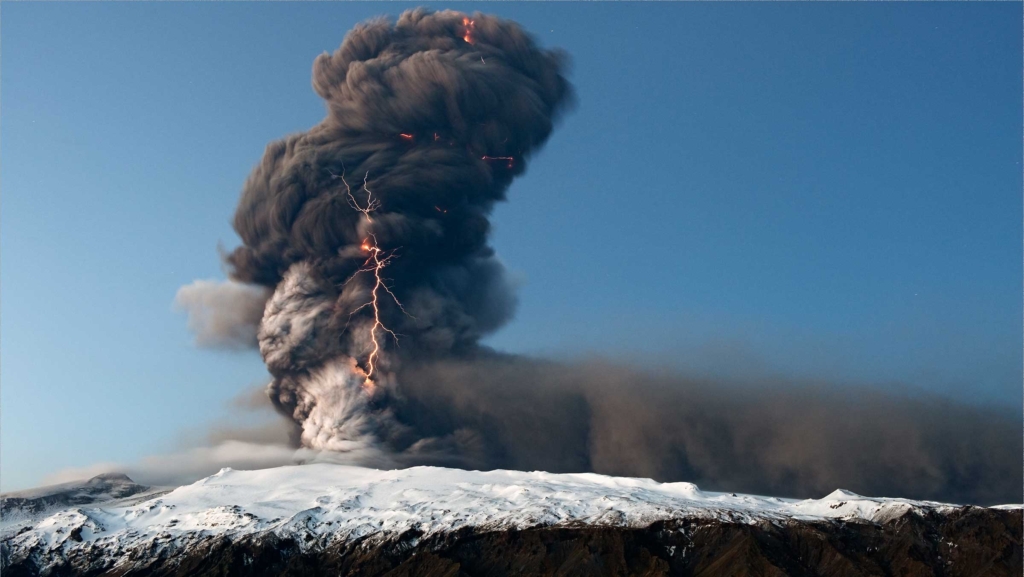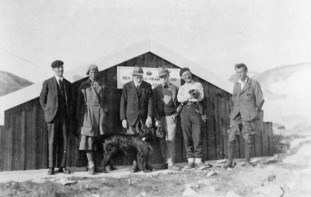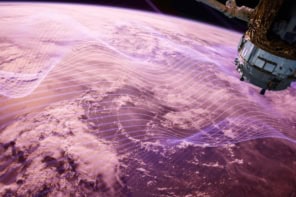Triggered by lightning in thunderstorms, whistler waves are radio waves that are channelled thousands of kilometres around the world via ducts in the magnetosphere. As Ian Randall reports, these mysterious waves have now been shown to come from volcanic lightning, too
It is the height of the First World War and, in the trenches, the German physicist Heinrich Barkhausen is eavesdropping on Allied telephone conversations. Using vacuum tube amplifiers and a couple of widely spaced metal prongs, the German forces are picking up on leakage from the enemy’s field telephone lines. Every now and then, though, the tapping effort is rendered fruitless – the Allied communications are drowned out by some very strange sounds.
The soldiers dubbed these nuisance noises “whistlers” because they sound similar to shells flying overhead. (To a modern ear, however, their descending “pee-yow” tone is more like a sound effect from an old-school space-themed arcade game.) Barkhausen was intrigued by the whistling noises and initially suspected a fault in the amplifying equipment. Once back in his laboratory in Dresden after the war, however, he was unable to reproduce the effect artificially – leading Barkhausen to conclude that whistlers are caused by an unidentified atmospheric phenomenon.
As it turned out, Barkhausen’s hypothesis was correct – although it would not be until the 1950s that the true source of whistler waves was identified. Whistlers are produced, bizarrely, from bolts of lightning thousands of kilometres away. That might seem very odd, as we usually associate lightning with the bright flashes of visible light that it produces. But lightning also creates very-low-frequency radio waves in the same way that an antenna emits radio waves: a moving charge creates an oscillating magnetic and hence electromagnetic field – an electromagnetic (radio) wave.
Hundreds of these bursts of radio waves – known as atmospherics, or “sferics” for short – are emitted every second from lightning strikes across the globe. Occurring at frequencies in the range of human hearing, the sferics can be converted directly into audible waves that sound like twigs snapping underfoot. Usually, sferics only travel a few thousand kilometres from their source, bouncing back and forth between the planet’s surface and the ionosphere (the ionized part of the upper atmosphere, which begins at an altitude of 60 km) before eventually attenuating.
In some cases, however, part of the energy penetrates the ionosphere and makes it into the plasmasphere. Also known as the inner magnetosphere, this doughnut-shaped region of space around the Earth consists of cool plasma and spans from an altitude of about 1000 km to as high as 32,000 km at the equator. In this region, the sferics can be guided along ducts – elongated channels that have either an irregularly low or high plasma density. Aligned with the north–south geomagnetic field, the ducts run from their starting location to the corresponding magnetic conjugate point in the opposite hemisphere. Unlike “antipodes” – places such as Christchurch in New Zealand and A Coruña in Spain that are directly opposite each other across the Earth – magnetic conjugate points are the two places where the same, arcing geomagnetic field line meets the Earth’s surface. Once the sferics reach this conjugate point at the other end of the duct, the small incident angle between the duct and the ionosphere may allow a small portion of the wave energy to pass back through the ionosphere and be received on the ground.

Passing through the magnetosphere is what turns sferics into whistler waves, with their eerie descending quality. “What gives them their unique tone is the dispersion they undergo as they travel through the magnetospheric plasma,” explains Claire Antel, a physicist from the University of Cape Town in South Africa, who has studied whistlers since 2012 and analysed whistlers in Antarctica as part of the South African National Antarctic Expedition. “High frequencies travel faster than the low, making them last a second or two.”
Location, location, location
Whistler waves might at first seem an interesting curiosity but one that has little, if any, wider relevance. In fact, the passage of whistlers between the hemispheres provides a rare opportunity to investigate the plasmasphere without needing to launch expensive space probes to do the job. By gaining a better understanding of this near-Earth region of space, we should be able to get better at anticipating the impact of space weather events. Although space weather isn’t the biggest threat to our planet, it has the potential – through local increases in radiation, high-energy particles or magnetic disturbances – to endanger astronauts and disrupt both orbiting and ground-based electronic systems. In extreme cases, geomagnetic currents induced by space weather have even been known to cause large-scale electrical blackouts.
Researchers who use whistlers to improve their understanding of the plasmasphere need to feed a few factors into their models. First they must measure the whistler’s frequency as a function of time, with the resulting spectrogram (figure 1) revealing the dispersion each wave has undergone on its journey between the hemispheres. What the researchers would then like to do is to use the extent of the dispersion to assess the magnetosphere’s electron density profile along the geomagnetic field line that the wave has just traversed, and elucidate the structure of the plasmasphere.
But here’s the problem: anyone wanting to do this calculation also has to know exactly where each whistler enters and leaves the plasmaspheric duct. Traditionally, it was assumed that whistler waves would enter ducts near to the lightning strikes that generated them. In other words, a whistler received in one hemisphere must have originated close to the corresponding conjugate point in the other – making the analysis relatively straightforward. But thanks to recent improvements in the automated analysis of whistler spectrograms, we now have a lot more data. These have shown, in contrast, that before whistlers enter a duct they can migrate significant distances sub-ionospherically, sometimes as far as 2500 km.

Whistlers recorded from Hungary’s Tihany Peninsula in 2009, for example, show correlations with both lightning recorded near the region’s conjugate point – off the South African coast – as well as strikes from as far afield as South America and south-east Asia. Similarly, whistlers observed on the Antarctic Peninsula appear to come from as diverse regions as Central America, Africa and Asia in addition to the conjugate point in the Gulf Stream. So there can in fact be a huge error in the entry-point variables that have so far been used in whistler-based models of the plasmasphere.
Specific in the Pacific
It is usually impossible to pinpoint the location of a lightning bolt that caused a particular whistler wave – because the original sferic can travel thousands of kilometres before it enters a duct. However, the location of a certain recording station in Dunedin, on New Zealand’s South Island, provides a unique opportunity. Dunedin’s magnetic conjugate point lies in the Aleutian Islands – a volcanic chain in the northern Pacific Ocean (figure 2). The islands include more than 40 active volcanoes – a fact that is key to a recent study by Antel and her international team of colleagues (2014 Geophys. Res. Lett. 41 4420). That is because where there is volcanic activity, volcanic lightning often follows (see box).
To study Dunedin’s whistlers, the researchers looked at correlations between lightning data from the World Wide Lightning Location Network – which detects sferics – and whistler data from the Automatic Whistler Detectors and Analyzer (AWDA) system, which includes the recording station in Dunedin. Using data sourced over the period from 25 May 2005 to 31 December 2013, the researchers were able to identify whistlers occurring within two seconds of any lightning stroke. Alongside this analysis, records of prominent, high-latitude volcanic eruptions were sourced from the Global Volcanism Program database.
The Aleutian chain includes three active volcanoes located near Dunedin’s magnetic conjugate point: Mount Okmok, Kasatochi Island and Mount Redoubt – distanced 350, 815 and 870 km from the conjugate point, respectively. During the time period studied, all three volcanoes erupted one or more times, with each event producing both lightning locally and corresponding whistlers in Dunedin.
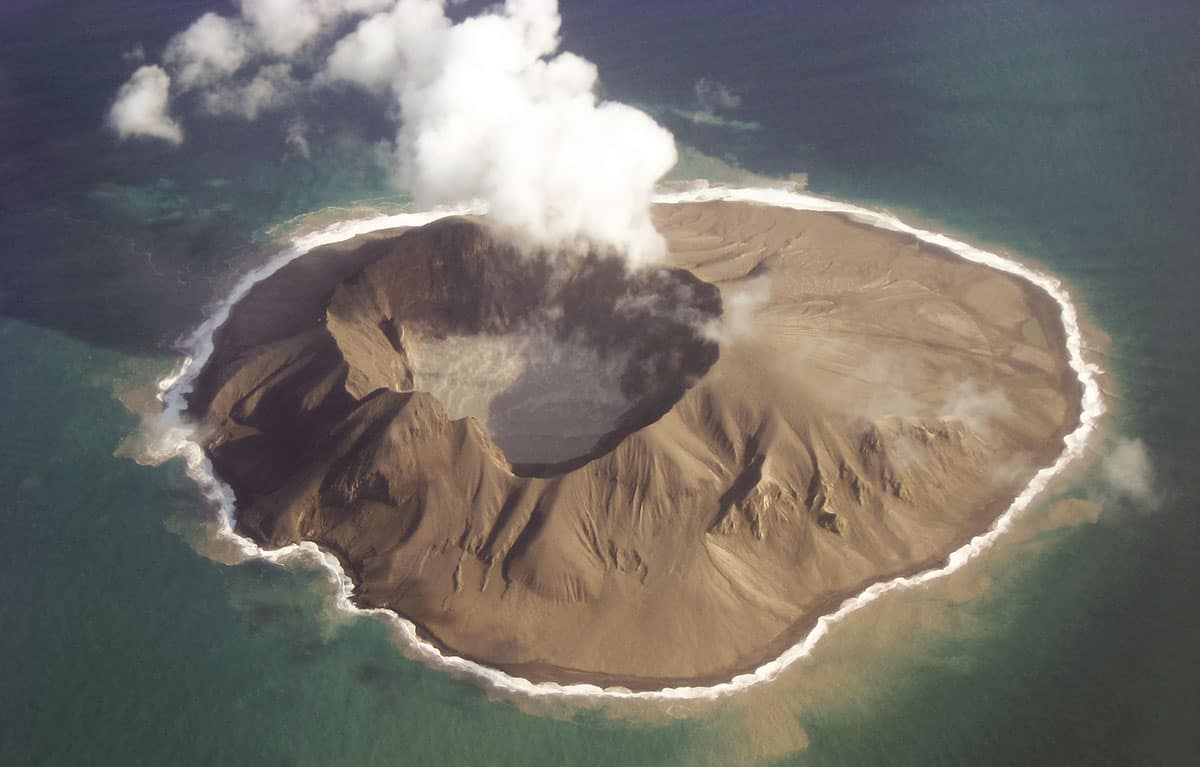
On 12 July 2008, for example, Mount Okmok erupted cataclysmically, releasing a 15 km high ash plume into the atmosphere. Within 35 minutes of the eruption, lightning strikes had been detected in the region of the volcano, and corresponding whistlers were also observed in Dunedin. By the end of the day, Dunedin’s whistler count had risen to more than 12,000 – a massive increase on the typical background rate of fewer than 500 observations per day, and one of the highest recorded counts in the AWDA’s eight-year history.
Mount Redoubt was also volcanically active during the study period and underwent 26 eruptive or explosive events in early 2009, many of which were accompanied by lightning. Of these, seven eruptions produced lightning that could be correlated to whistler activity, producing spikes in the whistler data ranging from 23 to 258 over barely a few minutes. Data from an eruption of the Kasatochi volcano in August 2008 also appeared to show a correlation between local lightning activity and whistlers detected in Dunedin, although the low rate of lightning activity – and the relatively high background level of whistlers around the eruption time – has made correlations for this particular event inconclusive, the researchers say.
Despite this, the researchers propose that the demonstrated correlations show that volcanic lightning can generate whistlers – providing the first evidence that volcanoes are able to couple with the inner magnetosphere. “I am left in awe,” says Antel, “at the immense influence volcanoes have on our planet!” Furthermore, the volcanic whistlers are certain to have originated near to Dunedin’s conjugate point – thereby providing accurately known travel paths between the two locations. “In other words,” Antel says, “the improved knowledge of whistler paths increases the fidelity of the plasmaspheric model that makes use of whistler data.”
Flashes in the ashes
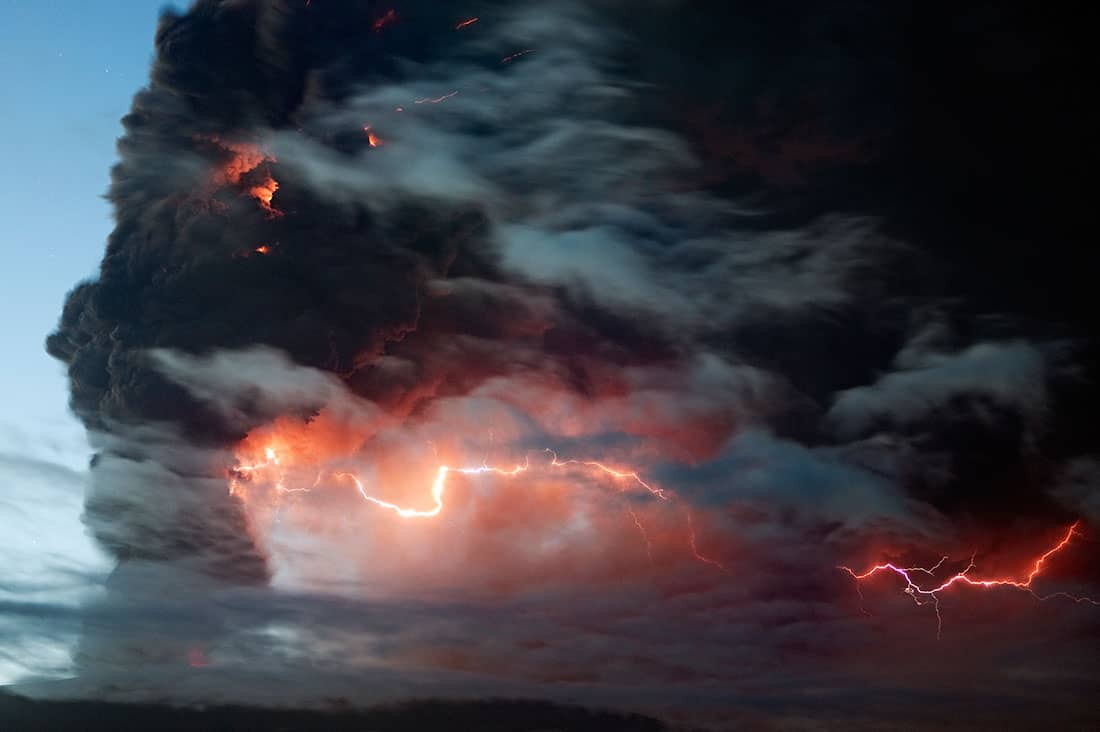
Like regular lightning, volcanic lightning develops from the generation and separation of charges. While volcanic lightning can occur with a variety of eruption styles – including those in which lava flows are the main type of erupted material – volcanologist Corrado Cimarelli of Ludwig-Maximilians-Universät Munich explains that “most of the time, lightning is observed during eruptions where a large quantity of volcanic ash is produced”. A number of charging mechanisms have been proposed to bring about these strikes, ranging from the freeing of ions and electrons from fractured rocks, to friction between particles, and the rising and condensing of cooling water vapour in the volcanic plume.
“Once charge has been generated in a volcanic plume,” says Karen Aplin, an atmospheric physicist from the University of Oxford, “it is separated by convection, carrying smaller particles upwards, whereas heavier – and often oppositely charged – particles settle under gravity.” If the potential difference created overcomes the breakdown potential of the air, lightning occurs to neutralize the charge build-up. However, the separation of charged particles is highly variable and is dependent on the type of volcano and local atmospheric conditions. “This variability,” says Aplin, “and the difficulty of making repeatable measurements, means that volcanic lightning remains poorly understood.”
Out of this world
Although this whistler study was very much Earth-based, Mark Golkowski, a plasma-physics expert from the University of Colorado Denver, believes that this proof that whistlers can be reliably generated by sources outside of precipitating clouds has ramifications beyond our own planet. “For example, on Mars there are no clouds to generate moisture-driven lightning, but lightning from dust storms has been postulated.” He adds that the volcanic-whistler findings support proposed studies to use dust-storm lightning on Mars to probe the weak plasma densities of the planet’s upper atmosphere.
Robert Marshall, an electrical engineer at Stanford University, thinks this first observation of whistlers being directly correlated to volcanic lightning is exciting and unique. However, he warns that it remains to be seen if and how these volcanic whistlers will contribute to our understanding of either volcanic lightning, or whistlers and the magnetosphere.
Yet even if volcanic whistlers are not intrinsically important, the researchers are certainly pleased with their novel discovery. “I like the idea that a volcanic explosion can produce a radio wave that goes approximately 20,000 km into space and then is detected in Dunedin,” says Craig Rodger, a physicist at the University of Otago, who took part in the study. “They are,” he concludes, “pretty damn cool!”
